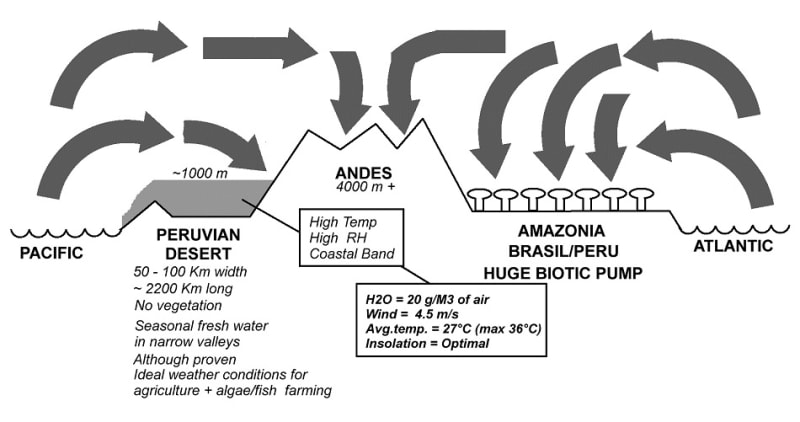We have been working in the design of water harvesters from air humidity for the Peruvian desert, based in our knowledge and practice, but there was lacking a general theory behind our task, until the "Biotic Pump" concept of Victor Gorshkov and Anastassia Makarieva of the St. Petersburg Nuclear Physics Unit became known, then our speculations and findings made sense and gave us a lot of confidence.
The big energy source of atmospheric water is in the phase change from vapour (measured as RH) to liquid (in fog, clouds, rain). We added to that some dessicant materials such as CaCl2, MgCl2, glycerol, H2SO4, molasses etc. are hygroscopic ( they absorbe atmospheric water vapour latent heat i.e. the dessicant becomes warmed) and also that there is another energy to account, which is the chemical reaction of hydration of the dessicant, that also generates heat. Then, we have two energy sources: the latent heat of water vapour in air and the heat generated by the hydration of the dessicant. CaCl2 can easily absorb 7 times its weight of water.
The energy that can be harvested has not a big temperature difference i.e. a 25°C collecting solution with a concentration of say 45% CaCl2 will end, in practical terms, with a 60°C to 90°C temperature. That is not a wide range for technologies like Bismuth Teluride termoelectrics, Rankine Cycle generators or Stirling motor designs. Although there is a theoretical hope in Cuprous Chloride termoelectrics that can work in that range of temperatures.
We have thought in a way that some of that energy can be put to work in simple, cheap and practical/operative designs. We propose a mix of water harvesting by dessicants; using the heat generated to harvest more atmospheric water by cooling more air and generating more water. As heat accumulated in solutions, after their use, will be still hot (about 50°C) can be used to warm something. That something can well be its aplication in microalgae farming which its best conditions for rendering 80-120 MT/Ha/year should have a brine temperature of around 35°C.
Microalgae farming for being a big busines for producing biomass out of enviroment + some fertilizers, tand can be processed for oil & feedstuffs requires 3 things: High average temperature, high RH (relative humidity...a wet climate) big insolation (for photosynthesis) and isolation from cities and agricultural terrains (predators can be carried by wind). One side remark: seawater for microalgae, contrary to common knowledge, is more expensive. Why? just because it must be sterilized (in order to kill the predators) to be efficient production wise.
So there are two sources of water, the one coming from hicroscopy and the one coming from reaching its dew point. Depending of the design, and this is more a design related to the place and conditions therein, that water can be used as potable, for drip irrigation agriculture, mining or what appears more profitable, algae/fungus/yeast farming.
Like this entry?
-
About the Entrant
- Name:Pedro Flecha
- Type of entry:individual
- Patent status:none





